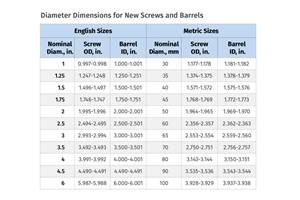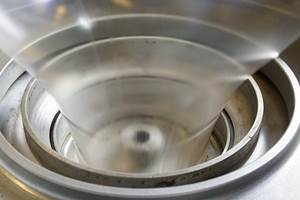A Plant Designed by Efficiency Experts
Hi-Tech Profiles Inc. in Pawcatuck, Conn., extrudes stock and custom medical and industrial profiles out of engineering resins that cost from $3 up to $35/lb.
Hi-Tech Profiles Inc. in Pawcatuck, Conn., extrudes stock and custom medical and industrial profiles out of engineering resins that cost from $3 up to $35/lb. Although it hardly sounds like it, the firm was primarily an automotive supplier until five years ago. "We had automotive sales that were worth millions, but at the end of the day, we didn't make any profit," says president and owner Raymond Quinlan. "It took more and more paperwork. We were being totally consumed."
Automakers paid Hi-Tech in 60 days, but resin suppliers wanted to be paid in 30. As a result, this small company ($7 million annual sales) sometimes carried $1 million in receivables. "Then they squeezed us harder on terms for ´óĎó´«Ă˝ that we weren't making money on anyway," he recalls. Quinlan set out to diversify and get out of debt.
Mission accomplished
Five years later, he has done both. Whereas Hi-Tech formerly had 40 employees to run 12 extrusion lines 24/7, today it has only 18 employees, including management, and runs 24/5. Three very skilled operators can run 10 or 12 lines. The company's bottom line is stronger, it's debt-free, and receivables are down to 30 days.
Hi-Tech still extrudes specialty profiles for Tier 1 automotive suppliers, such as TPU covers for emergency brakes. Two lines run round the clock on those jobs. Hi-Tech also still produces acetal and nylon stock shapes for distributors. But it has added over a dozen new customers.
Hi-Tech has a new 4000-sq-ft clean room with five new medical tubing ex truders, and a sixth is on order for processing high-temperature PEEK. Last year, Hi-Tech also set up a new subsidiary for die making with a CNC machine shop and two CAD workstations. Hi-Tech is now sought after for product design and development.
‘Tech service' mindset
Knowledge of efficient operations also helped the transition to diversified custom work. When Quinlan left Davis-Standard 18 years ago to start Hi-Tech, he came from the technical service department and brought two colleagues with him, Lydia Teixeira, now Hi-Tech's v.p. of finance, and Mark Ouellette, v.p. of development. "We were the suits who would go into a Davis-Standard customer and tell them how to extrude products more efficiently. One reason we went in ´óĎó´«Ă˝ for ourselves was that we thought we could do it better."
So they set up their shop with a highly efficient work flow. All 15 extruder lines are connected by an overhead catwalk, which facilitates material changes for the firm's varied product slate. Resin enters at truck bays on one side of the plant, is categorized, qualified, and made into product. Then it goes out at truck bays on the other side of the plant. Because Hi-Tech's resins are so costly, there is virtually no material storage, only temporary staging, and little inventory of finished goods except for stock shapes for distributors.
In June, Hi-Tech exhibited at its first medical trade show—MD&M East in N.Y.C. The firm displayed new multi-lumen, multi-layer, tight-tolerance medical tubing. Since then it has been "inundated with development work," Quinlan says, "just from one show."
That doesn't mean that all is smooth going. Hi-Tech discovered that smaller customers can renege on contracts just like big customers. One sent work overseas after consuming months of Hi-Tech's development time, just the way a big automaker once did.
"We still struggle with the ´óĎó´«Ă˝ model—how to charge properly for unique development work," Quinlan says. "It used to be that if you developed a product for a company that they couldn't make for themselves, they gave you the ´óĎó´«Ă˝." But that has changed in the last few years. "Manufacturers now have to think a lot more about what they're doing."
Related Content
Troubleshooting Screw and Barrel Wear in Extrusion
Extruder screws and barrels will wear over time. If you are seeing a reduction in specific rate and higher discharge temperatures, wear is the likely culprit.
Read MoreReduce Downtime and Scrap in the Blown Film Industry
The blown film sector now benefits from a tailored solution developed by Chem-Trend to preserve integrity of the bubble.
Read MoreHow To Identify Resin Degradation in Single-Screw Extruders
Degradation can occur in many single-screw extrusion operations, and typically occurs due to minor design flaws in the screw. Here is how to track it down.
Read MoreSingle vs. Twin-Screw Extruders: Why Mixing is Different
There have been many attempts to provide twin-screw-like mixing in singles, but except at very limited outputs none have been adequate. The odds of future success are long due to the inherent differences in the equipment types.
Read MoreRead Next
For PLASTICS' CEO Seaholm, NPE to Shine Light on Sustainability Successes
With advocacy, communication and sustainability as three main pillars, Seaholm leads a trade association to NPE that ‘is more active today than we have ever been.’
Read MoreBeyond Prototypes: 8 Ways the Plastics Industry Is Using 3D Printing
Plastics processors are finding applications for 3D printing around the plant and across the supply chain. Here are 8 examples to look for at NPE2024.
Read More









